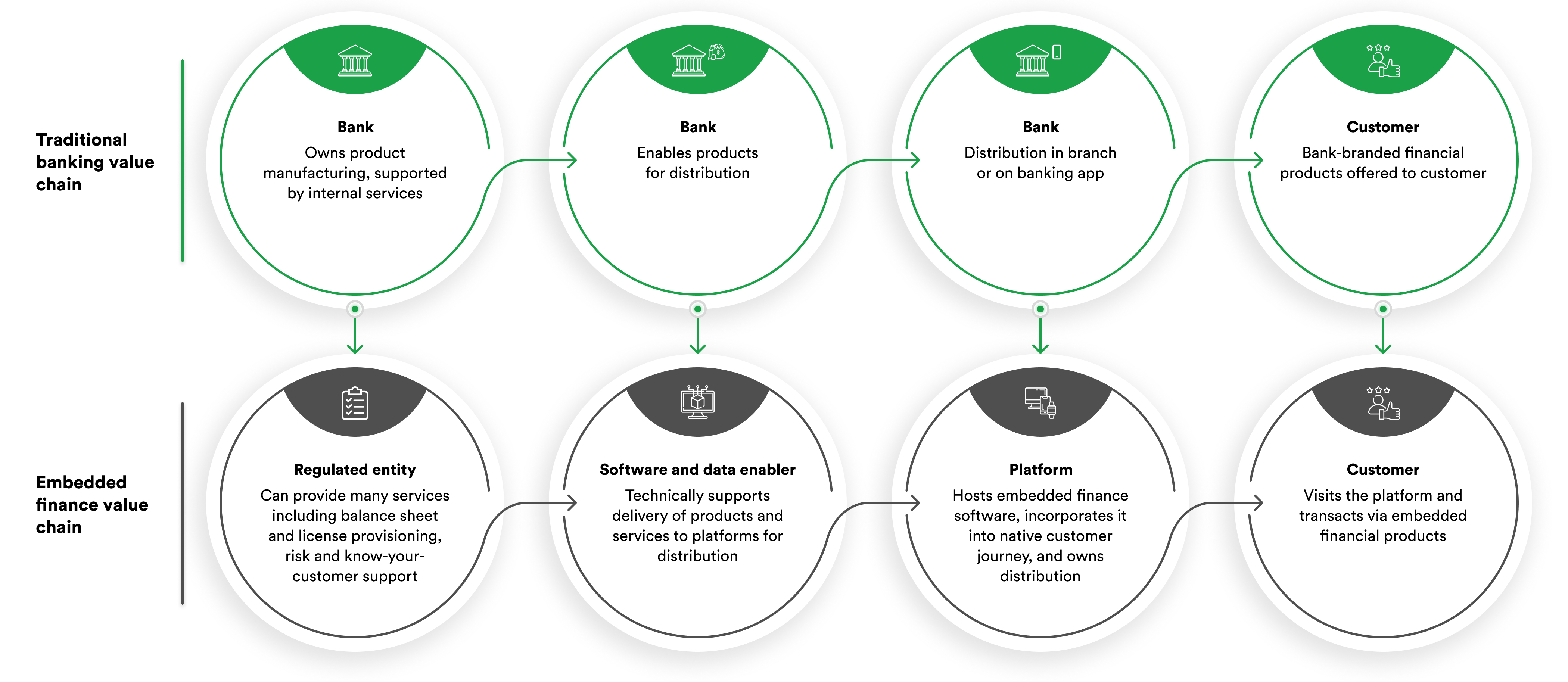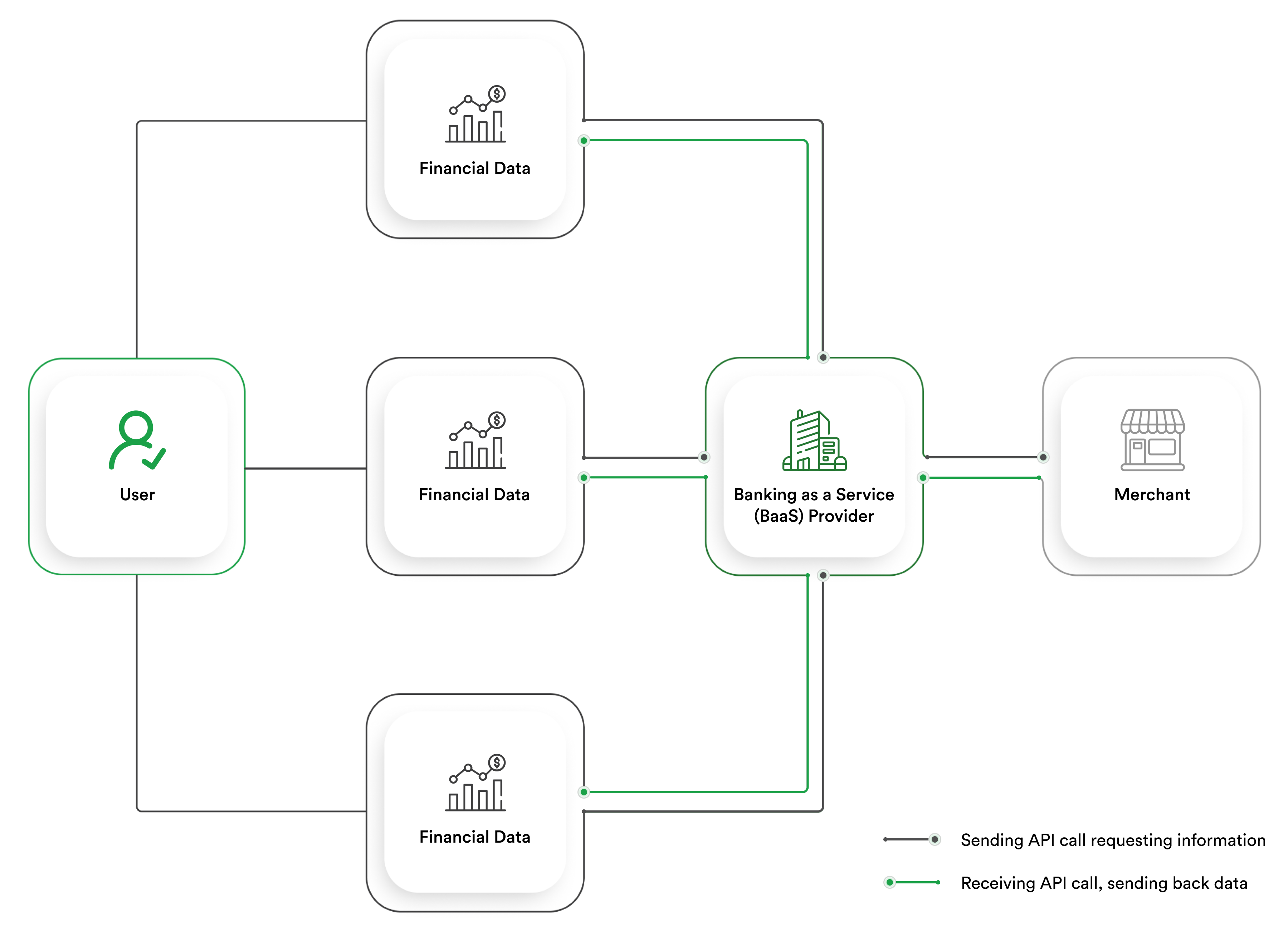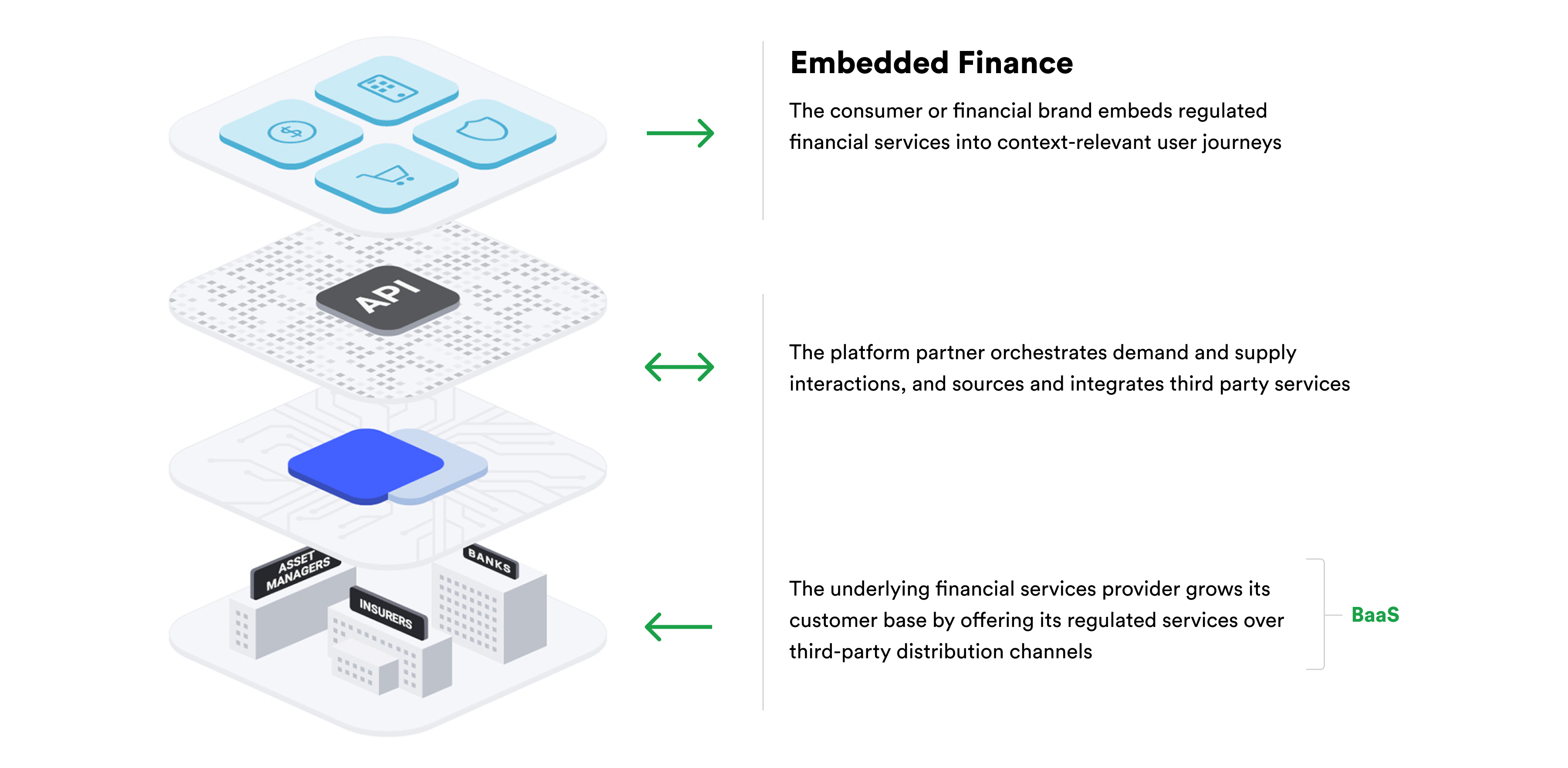
Unleashing the Power of Data: The API Economy and Open Banking
Exploring the immense potential of data-driven innovation within the financial services industry.
Below, you will find a comprehensive overview of embedded finance. It will highlight the embedded finance market size, provide embedded finance examples, and answer questions about embedded finance vs. banking as a service discussion. You will gather a holistic view of embedded finance solutions and how you can leverage various embedded finance developments to benefit your organization.
We will begin this post by answering the question on everyone’s minds: What is embedded finance?
Embedded finance is essentially the integration of financial services in traditionally non-financial platforms. Rapidly rising technological advancements have made embedded finance look like a radically new phenomenon. The truth is that embedded finance has been brewing for quite some time. An in-app transaction for a non-financial product or service like ridesharing or food delivery is a typical example of embedded finance that’s been around for many years. Other forms of embedded finance include embedded loan applications, investments, warranties, and insurance services.
The embedded finance market size stood above $66.8 billion last year and is expected to reach $622.9 billion by 2030 at a compound annual growth rate of 25.4%. The reason for this flourishing market is that traditional banking and financial services organizations are struggling to keep up with the demands of the modern world. Both the average end-consumer and enterprise can’t survive in a world with disjointed and laggardly financial systems.
End users demand faster, more seamless transaction and payment experiences. Therefore, businesses must integrate embedded financial services to stay competitive and acquire and retain customers. Furthermore, expensive economic infrastructure is a non-option for most small and medium enterprises. There’s also a rise in embedded finance solutions for B2B use cases that help non-financial organizations collaborate faster and more effectively.
The main reason behind swapping traditional financial services for embedded finance differs for various stakeholders. Customers want quicker, easier, and more customized payment solutions. Banks and other conventional financial organizations wish to remain relevant and competitive and continue acquiring, retaining, and managing a large number of customers. Enterprises want to use embedded finance and similar technologies to stay ahead of the pack in extremely competitive and saturated markets, enhance customer experience and satisfaction, and sell their financial services.
We’ve answered the question “What is embedded finance?”, explored the embedded finance market size, and provided the context that fuels numerous embedded finance trends. The following section will delve deeper into embedded finance examples and what they look like in the real world.

This section highlights four prominent categories of embedded finance examples – e-commerce, ridesharing, social media, and traditional industries.
The COVID-19 pandemic catalyzed the adoption of online shopping and reminded us how important embedded finance is for online retailers and their customers. Integrating embedded finance isn’t a simple option for online retailers due to various challenges and complexities. However, companies like Amazon and Shopify have demonstrated that embedded finance can be implemented successfully. These companies offer their customers a wide variety of flexible embedded payment solutions without the overhead costs and complexities associated with traditional banking.
Another common embedded finance example is ridesharing. Services like Lyft and Uber have become the go-to mode of transportation for millions. The only way to retain millions of customers is to ensure that payment isn’t a hassle. That’s why ridesharing companies feature some of the most innovative and transformative embedded finance examples. Uber has a range of embedded finance solutions that help customers pay, and drivers get paid. Other embedded finance-related innovations for Uber include Uber Wallets and Credit Cards. Implementing embedded finance can help such organizations transcend transportation and become multi-service providers.
Check out how we at rinf.tech helped a leading truck transportation and instant delivery company "uberize" routes planning and delivery ETAs, which resulted in 40% increase in daily deliveries and pickups and a high level of data processing.
According to the Pew Research Center, only 16% of American adults between 18 and 29 are not on social media. The number of people using social media platforms is rapidly increasing every minute. The mushrooming of social media consumers is both the cause and effect of commercial activity on platforms like Facebook, Instagram, and TikTok. McKinsey cites that social media commerce will account for over $80 billion by 2025. Therefore, it’s no surprise that social media companies are innovating and integrating embedded finance solutions into their offerings. Social media platforms are now marketplaces and embedded finance is the way to make those marketplaces successful.
Embedded finance isn’t only being implemented in ultramodern contexts. Many traditional industries, including manufacturing, healthcare, and real estate, are integrating embedded finance into their offerings. Healthcare institutions are empowering their customers with flexible embedded payment options like EMIs, subscription plans, and loan applications. Manufacturers are still tiptoeing around embedded finance, but there’s a gradual increase in B2B manufacturing procurements via embedded finance solutions. Trends suggest that embedded finance will eventually influence every major industry in the world.
The previous section focused on embedded finance examples, including e-commerce, ridesharing, social media, and even traditional industries like healthcare and manufacturing. But how are these embedded finance solutions being integrated into these industries at speed and scale? This section focuses on what makes embedded finance development and adoption possible, with a particular focus on technology, stakeholders, revenue models, and regulatory considerations.
Embedded finance combines powerful new technologies, including APIs and cloud computing. APIs are the bridges between banks, traditionally non-financial enterprises, and fintech mediators. APIs help port data between these key stakeholders at previously unseen speeds, providing embedded finance with its unique advantage of efficiency and seamlessness. Advancements in cloud computing form a powerful symbiosis with embedded finance. Robust and scalable cloud architectures help organizations dispense embedded finance services affordably, safely, and in compliance with various regulatory bodies. Cloud computing also provides mechanisms to analyze and collect critical financial data, a necessity of the modern world.

Innovations in fintech, like embedded finance, are powered not just by new technologies but by a reconfiguration of relationships between key stakeholders. Most embedded finance requires the involvement of traditional financial organizations like banks, mediatory services from fintech companies, and non-financial enterprises that want to integrate embedded solutions. In the context of embedded finance, banks are still the bedrock, albeit without traditional complexities and challenges. Fintech companies innovate technologies and solutions to interconnect and spread API-powered embedded financial services. Non-financial organizations are the end-beneficiaries, working with both fintech organizations and traditional financial institutions to provide their customers and clients with seamless and modern embedded financial services.
No fintech solution, irrespective of how exciting and revolutionary its technology is, can be sustained without bulletproof revenue models. The success of embedded finance largely depends on how much money organizations can make by implementing it. There are numerous revenue-related advantages of adopting embedded finance solutions, the most significant of which is creating new streams of revenue that were previously unrealized or impossible. By integrating embedded finance services, businesses can charge their customers for enhanced digital convenience. They can also establish a tariff for their embedded finance offerings. Remittance prices and official credit cards are common ways to profit from embedded finance services.
Regulatory compliance is often the dampener for the widespread adoption of modern innovations. However, it’s important to remember that compliance is a necessary hurdle, not a roadblock. Improving and maintaining compliance can provide a range of benefits, so it’s important to treat the regulatory considerations of embedded finance with the utmost gravitas. Businesses that adopt embedded finance need to pay attention to numerous compliance frameworks, both federal and local. They also have to maintain industry benchmarks. This is important because embedded finance connects multiple parties like customers, businesses, and banks over APIs. The benefits of API-powered connectivity are transformational, but it also means that a vast amount of sensitive data must be protected, and tunneling protocols must be compliant. Failing to protect the data and sensitive information of businesses, collaborators, third-party vendors, and consumers can result in reputational damage, damaged profit margins, cybersecurity disasters, and millions in legal fines.

This section highlights three important advantages of embedded finance that can help organizations stay ahead of their competitors.
Embedded finance provides a more streamlined user experience for customers, businesses, banks, and other middlemen. Embedded finance ensures that customers can choose specialized payment options and conduct transactions with just a few mouse clicks. Customers can also perform financial activities within typically non-financial apps. The modern consumer has no patience for lags and disruptions. Similarly, businesses can’t afford long processing times and bureaucratic hurdles to conduct financial activities. This makes efficient and effective user experience one of the key benefits of embedded finance solutions.
We mentioned earlier that integrating embedded finance can enable businesses to craft new income streams. Global marketplaces are unimaginably crowded. Modern operations’ velocity, affordability, and scalability mean that the gap between big players and new entrants is being reduced. Every business is looking for slivers of competitive advantage to remain leaders in their fields. Embedded finance can transform enterprises from all sectors into well-reputed financial service providers. This allows them to charge their customers for many unique, value-adding services that didn’t exist before.
The challenge of crowded business landscapes is that it becomes increasingly difficult to maintain a unique brand that offers unique value. Endless innovations and digital transformation initiatives result in numerous businesses having similar-looking offerings. Implementing embedded finance can help organizations stand out in these markets. Embedded finance looks like an eventuality rather than a possibility, but businesses must act fast. Companies that adopt innovative embedded finance solutions can now gain a significant head start and stand out from their competition with distinctive offerings.
We’ve established that an enhanced user experience, increased revenue opportunities, and market differentiation are some of the key advantages of embedded finance. Let’s shift focus to some of the hurdles that need to be overcome to unlock those benefits. This section features the disadvantages of embedded finance, namely security concerns, regulatory hurdles, and the potential for financial exclusion.
Data privacy and security are some of the biggest challenges for enterprises. Financial data is amongst the most private, high-value, and sensitive data. It can be disastrous for financial data to be exposed to the public or exfiltrated by threat actors. Data breaches can profoundly ruin companies. The average cost of a data breach in 2023 is $4.45 million, which means that the security concerns associated with embedded finance need to be addressed as a priority. Businesses can’t afford security lapses, especially when the crown jewel is financial data.
HIPAA. PCI-DSS. CCPA. GDPR. The list of compliance frameworks and requirements is seemingly endless, but companies have no option but to stringently abide by them. Every new era in an enterprise’s evolution brings new regulatory hurdles. The implementation of embedded finance is no exception. The regulatory complexity associated with embedded finance directly results from the number of stakeholders involved. Consumers, fintech organizations, and banks all have different rules they need to follow, and the intersections of these worlds mean that data from disparate sources is exchanged in vast quantities and in real time. Abiding by regulations is the second part of the puzzle. The first challenge for enterprises adopting embedded finance is understanding the contours of compliance requirements and every nuance.
The intent, philosophies, and theories behind numerous fintech innovations are inclusive and designed to serve a wide demographic. Unfortunately, the fact of the matter is that poorly implemented fintech innovations, including embedded finance, can do even more damage than the status quo. It can further exclude financially marginalized people. In this context, financial marginalization refers to large portions of the population having zero or suboptimal access to financial services. The pitfalls of traditional banking and social inequity are that the road to inclusion is riddled with roadblocks. Enterprises need to remember that embedded finance can be an excellent tool for inclusion, but only if designed and implemented with intention. The results of negligent embedded finance can further divide certain sections of society from critical financial services.
There’s no limit to embedded finance development. We may witness many innovations that make today’s finance technologies appear primitive. There are a few embedded finance trends, however, that are sure to make a mark shortly. The biggest of these embedded finance trends include a rise in DeFi, the proliferation of AI-powered mechanisms and big data analytics, cloud innovations, and a surge in edge computing.
The unraveling of the embedded finance vs. banking as a service debate will also define embedded finance trends over the next few years. All stakeholders, from banks and customers to fintech organizations and traditional sectors, will have to rethink traditional roles and notions to succeed in the world of modern finance. Failure to innovate can be disastrous. Successfully implementing embedded finance solutions can be a game-changer.
Embedded finance is an exciting but complex fintech innovation that can transform the financial activities of industries, organizations, and individuals. Embedded finance is appearing across sectors. It’s most commonly seen in e-commerce, ridesharing, and social media contexts, but traditional industries like healthcare and manufacturing are also exploring its potential.
The key to understanding embedded finance is to anatomize the technology behind it, map stakeholder relationships and responsibilities, decode new revenue models, and pay heed to regulatory complexities. Successful embedded finance can lead to better user experience, more revenue generation, and market differentiation. Suboptimal implementation can lead to security disasters, compliance failures, and participation in financial exclusion. The best way to ensure quality implementation of embedded finance is to work with a tech partner like rinf.tech.
We at rinf.tech can help your organization unlock the potential of embedded finance solutions and chart a course into the complex and exciting financial services landscape of the future.

Exploring the immense potential of data-driven innovation within the financial services industry.

A comprehensive overview of how fintech innovations drive significant changes in the retail industry.

Examining AI’s diverse effects on finance, delving into its advantages and obstacles, aiming to understand its transformative influence and future impact on the sector.